
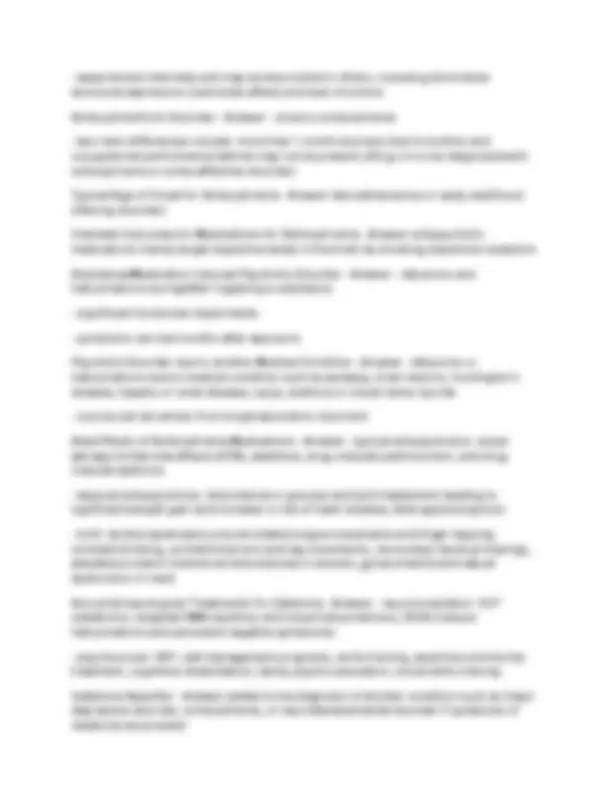
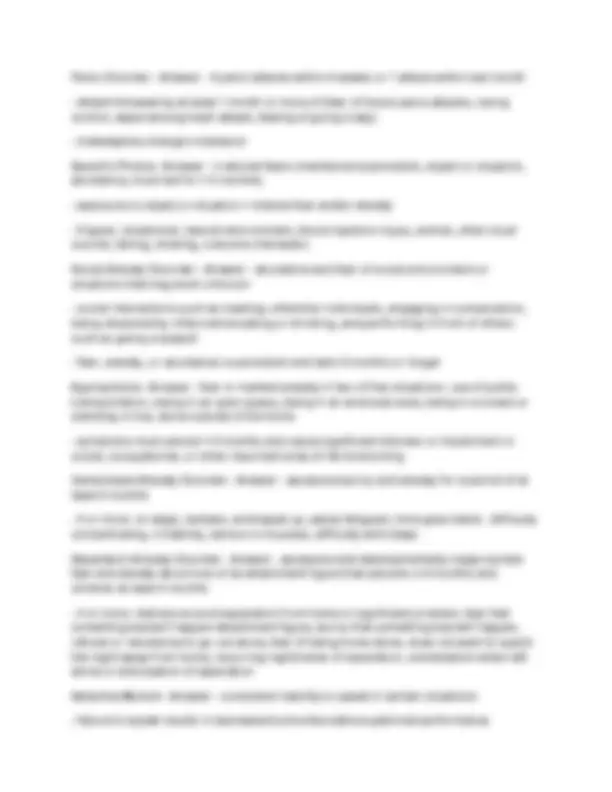
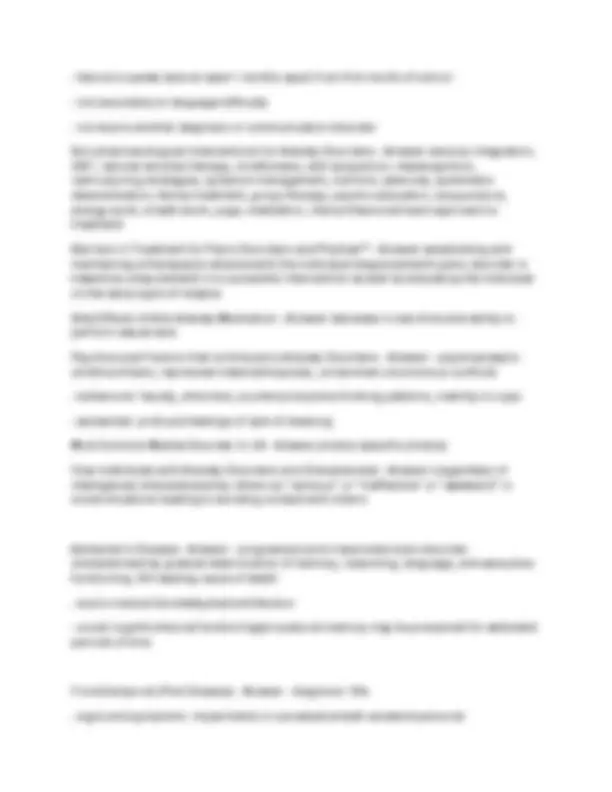
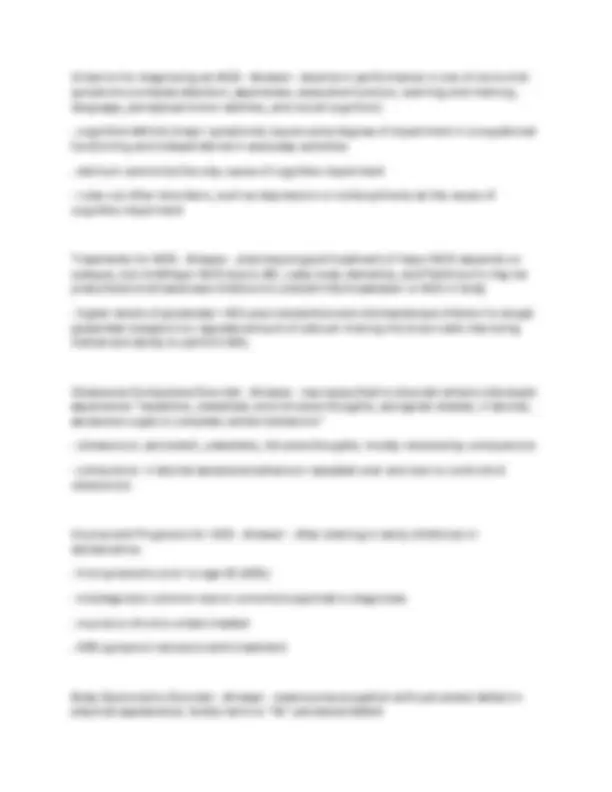
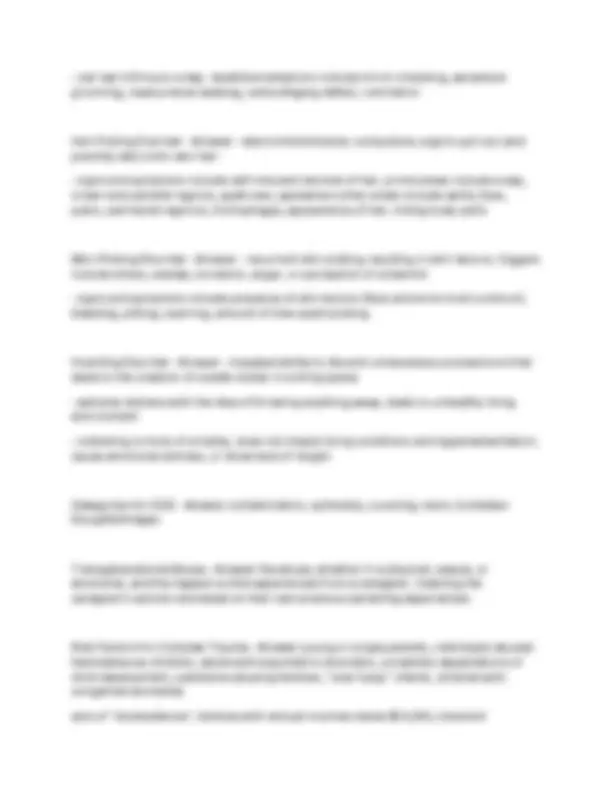
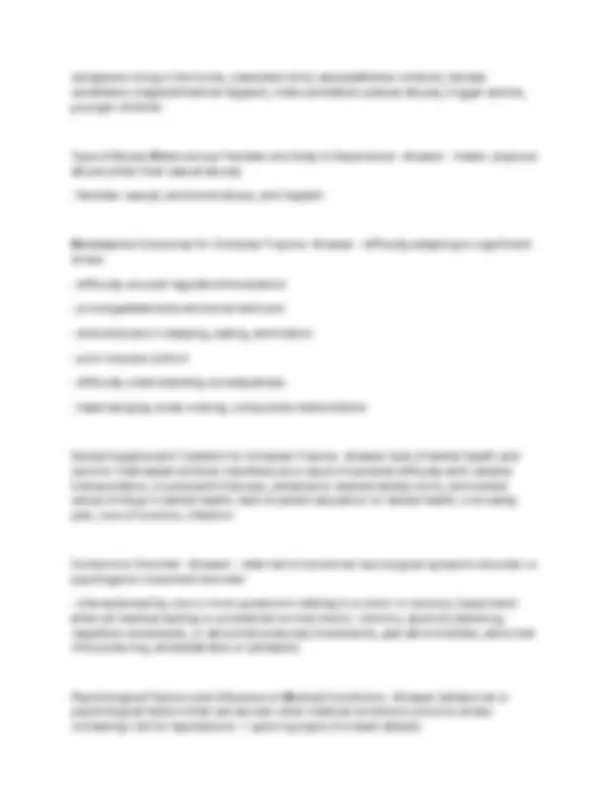
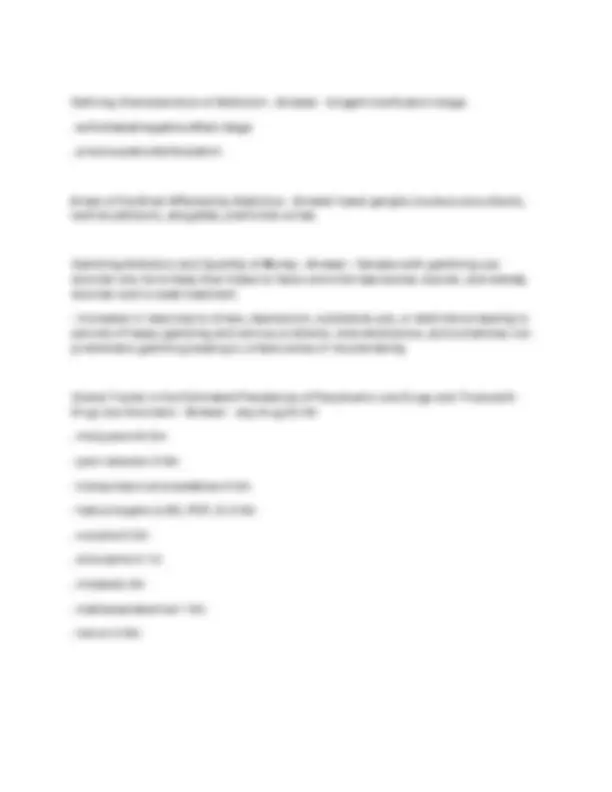


Study with the several resources on Docsity

Earn points by helping other students or get them with a premium plan


Prepare for your exams
Study with the several resources on Docsity

Earn points to download
Earn points by helping other students or get them with a premium plan
Community
Ask the community for help and clear up your study doubts
Discover the best universities in your country according to Docsity users
Free resources
Download our free guides on studying techniques, anxiety management strategies, and thesis advice from Docsity tutors
OT5012 Exam 2 Study Guide 2025-2026
Typology: Exams
1 / 13

This page cannot be seen from the preview
Don't miss anything!








Brain Abnormalities of MDD - Answer - functional abnormalities found in the limbic system (represents centers of emotions); also changes in hippocampus -- results in blunted or decreased behavioral and physiological reactivity to sad or negative stimuli
Mania versus Hypomania - Answer - manic: euphoria, irritability, grandiosity, decreased sleep impulsivity, and distractibility (interferes with daily functioning); highly elevated or irritable mood lasting at least 1 week, with or without psychotic symptoms such as delusions and hallucinations
BPD Manic versus Depressive Symptoms - Answer - manic: grandiosity, persistent elevated mood, minimal need for sleep, excessively talkative or having pressured speech, racing thoughts or flights of ideas, distractibility, excessive goal-directed activity or psychomotor agitation, impulsivity or participation in dangerous or risky activities, purchasing sprees, hyper sexuality, short-temper
Alternative Treatments for MDD - Answer - pharmacology: antidepressants that regulate neurotransmitters particularly serotonin and norepinephrine (SSRIs and SNRIs), tricyclics and MAOIs (lithium for BDD)
Course of Action for Suicidal Ideation - Answer it is important for OTs to be aware of signs and symptoms of suicidal ideation so they can identify them in their clients and make timely referralsterm-
Positive Symptoms - Answer - delusions: fixed false beliefs; don't change even when the
individual is presented with new information or evidence against the belief
Schizophrenia and Genetics - Answer - strong genetic component; risk for immediate family members is 10% and 50% in twin studies
Delusional Disorder - Answer - 1 or more delusional belief for > 1 month
Brief Psychotic Disorder - Answer - sudden onset of positive psychotic symptoms lasting between 1 day and 1 month
Schizoaffective Disorder - Answer - presence of major mood episode (major depressive, manic, or mixed episode)
Negative Symptoms - Answer - avolition, alogia, anhedonia, asociality
Panic Disorder - Answer - 4 panic attacks within 4 weeks or 1 attack within last month
Specific Phobia - Answer - irrational fears (marked and persistent, object or situation, avoidance, must last for > 6 months)
Social Anxiety Disorder - Answer - avoidance and fear of social environment or situations that may elicit criticism
Agoraphobia - Answer - fear or marked anxiety in two of five situations: use of public transportation, being in an open space, being in an enclosed area, being in a crowd or standing in line, alone outside of the home
Generalized Anxiety Disorder - Answer - excessive worry and anxiety for a period of at least 6 months
Separation Anxiety Disorder - Answer - excessive and developmentally inappropriate fear and anxiety about loss of an attachment figure that persists in 6 months and children at least 4 months
Selective Mutism - Answer - consistent inability to speak in certain situations
Non-pharmacological Interventions for Anxiety Disorders - Answer sensory integration, CBT, rational emotive therapy, mindfulness, skill acquisition, metacognition, restructuring strategies, symptom management, nutrition, exercise, systematic desensitization, family treatment, group therapy, psycho-education, acupuncture, energy work, breath work, yoga, meditation, interprofessional team approach to treatment
Barriers in Treatment for Panic Disorders and Phobias** - Answer establishing and maintaining a therapeutic alliance with the individual diagnosed with panic disorder is viewed as a key element in a successful intervention as well as educating the individual on the early signs of relapse
Side Effects of Anti-Anxiety Medication - Answer decrease in sex drive and ability to perform sexual acts
Psychosocial Factors that contribute to Anxiety Disorders - Answer - psychoanalytic: childhood fears, repressed material/impulses, unresolved unconscious conflicts
Most Common Mental Disorder in US - Answer phobia (specific phobia)
How Individuals with Anxiety Disorders are Characterized - Answer (regardless of intelligence) characterized by others as "nervous" or "ineffective" or "awkward" in social situations leading to avoiding contact with others
Alzheimer's Disease - Answer - progressive and irreversible brain disorder characterized by gradual deterioration of memory, reasoning, language, and executive functioning; 6th leading cause of death
Frontotemporal (Pick Disease) - Answer - diagnosis: 60s
Human Immunodeficiency Virus (HIV) - Answer - neuromotor features (severe incoordination, ataxia, motor slowing)
Strategies for Delaying/Slowing Down Cognitive Decline - Answer public health approach to addressing lifestyle-related risk factors is recommended to delay or slow cognitive decline/dementia (physical inactivity, tobacco use, unhealthy diets, harmful use of alcohol, social isolation, and cognitive inactivity)
Delirium - Answer - disturbance in attention with decreased ability to focus, sustain, or shift attention
Types of Delirium - Answer - hyperactive: symptoms present with lethargy, increased daytime sleeping, or even depression
Types of NCD asscoiated with Falls - Answer NCD due to Lewy body disease frequently experiences repeated falls and syncope and transient episodes of unexplained loss of consciousness
Criterion for diagnosing an NCD - Answer - decline in performance in one of more mild symptoms (complex attention, awareness, executive function, learning and memory, language, perceptual-motor abilities, and social cognition)
Treatments for NCD - Answer - pharmacological treatment of major NCD depends on subtype, but mild/major NCD due to AD, Lewy body dementia, and Parkinson's may be prescribed cholinesterase inhibitors to prevent the breakdown or ACh in body
Obsessive-Compulsive Disorder - Answer - neuropsychiatric disorder where individuals experience "repetitive, unwanted, and intrusive thoughts, alongside related, irrational, excessive urges to complete certain behaviors"
Course and Prognosis for OCD - Answer - often starting in early childhood or adolescence
Body Dysmorphic Disorder - Answer - severe preoccupation with perceived defect in physical appearance; bodily harm to "fix" perceived defect
caregivers living in the home, unwanted child, adopted/foster children, female caretakers (neglect/medical neglect), male caretakers (sexual abuse), trigger events, younger children
Type of Abuse Males versus Females are likely to Experience - Answer - males: physical abuse (other than sexual abuse)
Maladaptive Outcomes for Complex Trauma - Answer - difficulty adapting to significant stress
Dental Hygiene and Toddlers for Complex Trauma - Answer lack of dental health and care for maltreated children manifests as a result of parental difficulty with reliable transportation, trouble with finances, distance to nearest dental clinic, diminished sense of value in dental health, lack of parent education on dental health; oral cavity pain, loss of function, infection
Conversion Disorder - Answer - referred to functional neurological symptom disorder or psychogenic movement disorder
Psychological Factors and Influence on Medical Conditions - Answer behavioral or psychological factors that can worsen other medical conditions (chronic stress increasing risk for hypotension → ignoring signs of a heart attack)
Factitious Disorder - Answer - Munchausen syndrome: people who exaggerate their symptoms not for financial gain but for increased sympathy
Somatoform Disorders and Healthcare Costs - Answer healthcare costs for people with somatoform disorder are twice those for people with other medical conditions in the U.S.
Most Reported Somatic Symptom - Answer pain
DSM-5 Diagnostic Criteria for Somatic Symptom Disorder - Answer - a perception of any somatic symptom being persistent for more than 6 months
Important Components for Managing Somatic Symptoms - Answer reducing health-related anxieties, preoccupation with health concerns, and modifying or substituting maladaptive illness behaviors; cognitive behavioral therapy; dialectical behavior therapy
Anorexia Nervosa - Answer - profound refusal to maintain a normal body weight
Bulimia Nervosa - Answer binge eating and purging of food to avoid weight gain
Defining Characteristics of Addiction - Answer - binge/in-toxification stage
Areas of the Brain Affected by Addiction - Answer basal ganglia (nucleus accumbens, ventral pallidum), amygdala, prefrontal cortex
Gambling Addiction and Quantity of Money - Answer - females with gambling use disorder are more likely than males to have comorbid depressive, bipolar, and anxiety disorder and to seek treatment
Global Trends in the Estimated Prevalence of People who use Drugs and Those with Drug Use Disorders - Answer - any drug 52.2m